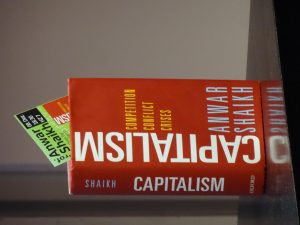The World Oscillates Between Crises and Protests
✑ TRICONTINENTAL INSTITUTE` ╱ ± 12 minutes


A quick overview of planetary affairs. From the age of austerity to the emerging bipolar world.

In the interim, ‘chaos and disorder’ will define the world.

A quick overview of planetary affairs. From the age of austerity to the emerging bipolar world.
From: Tricontinental Institute, January 7, 2020. ╱ About the author
Tricontinental: Institute for Social Research is an international, movement-driven institution focused on stimulating intellectual debate that serves people’s aspirations, directed by Indian historian and journalist Vijay Prashad.
| Editor’s note: This dossier is part of a longer series of dossiers published by Tricontinental: Institute for Social Research, an international, movement-driven institution focused on stimulating intellectual debate that serves people’s aspirations. |
|---|
We live in a time of protests: no country is immune from demonstrations that flood the streets and make demands upon structures that are deaf to the needs and aspirations of the people. Millions of people experience the pain and indignity of unemployment and cuts in State spending on education, health, poverty alleviation, and elderly care. The slogans are in different languages, but the meaning is the same: we refuse, we resist, we will not tolerate the plague of austerity.
Our January dossier provides a quick overview of planetary affairs (Part 1) and more detailed reports from our offices on their respective regions: South Africa, India, as well as the Caribbean and Latin America (Part 2).
Part 1. Debt and Despair
During the credit crisis a decade ago, the United States government led a global effort to raise funds – largely underwritten by the US Federal Reserve Bank – to stabilise financial markets and prevent a total collapse of the financial system. The urgency was palpable, with conferences held at regular intervals to get countries with financial surpluses to put money towards the bailout of financial institutions. No such urgency has been displayed towards the acute problems of unemployment, hunger, disease, and the general cannibalisation of social institutions. No infusion of capital has swept in to feed the almost 1 billion hungry people across the planet. According to the Global Hunger Index (2019), 43 of 117 countries have levels of hunger that are marked as ‘serious’. High use of toxins on crops and worsened nutritional value of cultivated food threaten to increase the number of people who are deficient in zinc and suffer from protein deficiency. There has been no serious conference of world leaders to address this issue; nothing like the panic that ensues when financial markets quiver.
Reports from central banks and from the UN agencies suggest that the period ahead in the West and in the Global South will be characterised by low investment of capital into the manufacturing and service sector, stagnant productivity in most fields, and consequentially low growth rates. Low global growth rates and low investment deepen problems of employment and further the collapse of social institutions.
The International Monetary Fund (IMF) anticipates that a global slowdown could take place as early as 2021. In its World Economic Forecast (October 2019), the IMF projected global growth for 2019 at 3.0 percent, ‘its lowest level since 2008-09’, with a marginal increase in 2020. This marginal increase is based on expectations of improved economic activity in ‘Latin America, the Middle East, and emerging and developing Europe’. Hope rests on recoveries in Brazil, Mexico, Hungary, and Poland, as well as on Saudi Arabian oil exports. This is a fragile hope from the IMF. Parts of these regions have been engulfed in the wave of protests, whether across Latin America, North Africa, or West Asia.
From the IMF, and from its allied policy advocates, comes the narrowest solution for the planet: continue with the policy of austerity domestically and end the trade tensions internationally. This is an incoherent policy position, since it does not appreciate that the trade tensions are a mirror of the hollowing out of society by austerity. One has led to the other, and they both feed on each other.
The Age of Austerity
The age of austerity opened up about fifty years ago with the surrender of much of the Third World to the escalating global debt crisis and the dissolution of the Soviet Union. Under pressure from the debt crisis, and with little other access to finance, the Third World was strong armed into adopting policies of austerity. Several developments are important to highlight for the production of the age of austerity.
The Chief Economist at the IMF, Gita Gopinath, writes in the introduction to the 2019 World Economic Forecast that there is ‘an urgent need for policymakers to cooperatively de-escalate trade and geopolitical tensions’. She has in mind the ‘trade war’ between the United States and China, which has created turbulence in the inter-State trade system (see Dossier no. 7, The Imperialism of Finance Capital and ‘Trade Wars’). But it is precisely the ‘policymakers’ who have produced the social basis for this trade war, namely the regime of austerity.
The Bipolar World
In 2009, five major countries of the world – Brazil, Russia, India, China, and South Africa – formed the BRICS bloc. This bloc is now a decade old. When BRICS emerged, there was much talk of the end of the era of ‘unipolarity’ – with the United States as the anchor for the global order – and of the emergence of the era of ‘multipolarity’. BRICS laid out an agenda to create institutions that were parallel to but different from the institutions controlled by Washington, DC; these included development banks and ratings agencies. Over the course of the decade, three of the BRICS States – Brazil, India, and South Africa – saw major internal transformation. Class fractions committed less to social democracy and more to full-throated neoliberalism; in India and Brazil, neofascism came to power. Such a commitment to neoliberalism, and in some cases neofascism, tilted these States towards subordination to the United States. Any previous hope for BRICS to be a plank of multipolarity began to dissipate.
While Brazil, India, and South Africa are no longer major players in the creation of a ‘non-aligned’ or multipolar institutional landscape, Russia has emerged as a partner to China in the move to a bipolar world. China and Russia have come together to help shape this new bipolar system for at least two reasons:
China’s growing partnership with Russia, however, has provided a platform for it to take foreign policy positions that are divergent from those of Washington, DC. Examples of this are to be found in China’s positions on Iran, Japan (Diaoyu Islands), Syria, Ukraine, and Venezuela.
As the bipolar order begins to take shape, the centre of gravity for the international order will oscillate between Washington, DC and Beijing. Either these two powers will come to some understanding over the international organisations – such as the IMF and the World Bank – or more regional organisations will appear with different standards and a more heterogenous understanding of trade and development. Whether these fissiparous tendencies will make an impact on the world financial system is not part of any of these discussions, which seems to indicate that it will remain intact. For countries in the Global South, the implication of continuities of financial power means that no major change at a global level will be possible in this bipolar dispensation. What alternatives there will be for austerity regimes are unclear.
See "Part 2. Reports from the Continents" (excluded here) of this dossier here: brief reports on the political, economic and social conflicts in South Africa, India and Latin America and the Caribbean.
Our January dossier provides a quick overview of planetary affairs (Part 1) and more detailed reports from our offices on their respective regions: South Africa, India, as well as the Caribbean and Latin America (Part 2).
Part 1. Debt and Despair
During the credit crisis a decade ago, the United States government led a global effort to raise funds – largely underwritten by the US Federal Reserve Bank – to stabilise financial markets and prevent a total collapse of the financial system. The urgency was palpable, with conferences held at regular intervals to get countries with financial surpluses to put money towards the bailout of financial institutions. No such urgency has been displayed towards the acute problems of unemployment, hunger, disease, and the general cannibalisation of social institutions. No infusion of capital has swept in to feed the almost 1 billion hungry people across the planet. According to the Global Hunger Index (2019), 43 of 117 countries have levels of hunger that are marked as ‘serious’. High use of toxins on crops and worsened nutritional value of cultivated food threaten to increase the number of people who are deficient in zinc and suffer from protein deficiency. There has been no serious conference of world leaders to address this issue; nothing like the panic that ensues when financial markets quiver.
Reports from central banks and from the UN agencies suggest that the period ahead in the West and in the Global South will be characterised by low investment of capital into the manufacturing and service sector, stagnant productivity in most fields, and consequentially low growth rates. Low global growth rates and low investment deepen problems of employment and further the collapse of social institutions.
The International Monetary Fund (IMF) anticipates that a global slowdown could take place as early as 2021. In its World Economic Forecast (October 2019), the IMF projected global growth for 2019 at 3.0 percent, ‘its lowest level since 2008-09’, with a marginal increase in 2020. This marginal increase is based on expectations of improved economic activity in ‘Latin America, the Middle East, and emerging and developing Europe’. Hope rests on recoveries in Brazil, Mexico, Hungary, and Poland, as well as on Saudi Arabian oil exports. This is a fragile hope from the IMF. Parts of these regions have been engulfed in the wave of protests, whether across Latin America, North Africa, or West Asia.
From the IMF, and from its allied policy advocates, comes the narrowest solution for the planet: continue with the policy of austerity domestically and end the trade tensions internationally. This is an incoherent policy position, since it does not appreciate that the trade tensions are a mirror of the hollowing out of society by austerity. One has led to the other, and they both feed on each other.
The Age of Austerity
The age of austerity opened up about fifty years ago with the surrender of much of the Third World to the escalating global debt crisis and the dissolution of the Soviet Union. Under pressure from the debt crisis, and with little other access to finance, the Third World was strong armed into adopting policies of austerity. Several developments are important to highlight for the production of the age of austerity.
- Technological. Capitalism, which has global ambitions, had been constrained by certain technological limitations. These limitations have now been overcome. They include:
- High quality telecommunications systems that have united the world in real time.
- Computerisation, which provided firms with the ability to manage complex databases, and therefore to coordinate logistics.
- Efficient logistics and standardisation. The arrival of containers for shipping cut time down for transportation and for the distribution of goods. The International Organisation of Standardisation’s stringent rules made it possible to source goods from any part of the world; grades of electric cable and types of glass become standard.
- Political. The weakness of the USSR and of the Third World after the economic and political crisis in the Warsaw Pact countries, and after the Third World debt crisis, meant that a challenge to capitalism in international institutions dwindled – particularly regarding trade, development, and labour. As the USSR collapsed and the Third World surrendered, millions of workers were delivered to capitalist firms.
- Economic. These hundreds of millions of workers competed with each other, allowing wage arbitrage to become a central aspect of the work of firms. The disarticulation of production (which we discuss in our Working Document 1: In the Ruins of the Present) allowed transnational firms to rely upon sub-contracted manufacturing, which meant that these firms neither invested in production nor did they take any risk; that was borne by sub-contractors in Third World countries. Profit margins for the transnational firms ballooned, even as growth rates typically stagnated.
- Social. These transnational firms and their sub-contracted entities began a decades long tax strike; the amount of money squirreled away in tax havens increased dramatically. The Tax Justice Network estimates that the total amount of wealth hidden in tax havens is $32 trillion – an amount that is worth four and a half times the total value of gold that has been mined and is in circulation anywhere in the world. The removal of so much social wealth, so much privately accumulated surplus value from social production, came at the same time as Third World governments – under pressure from the US Treasury Department and its allies – pushed against deficit spending and for balanced budgets. With less tax revenue coming in, and with a wall against deficit spending, States – with various political orientations –made massive cuts, not on military spending but on the social side, with health care, education, elderly care and poverty alleviation seeing the most substantial cuts.
- Austerity. The world of austerity fractured society, putting enormous pressure on whatever social forms were able to survive capitalism’s undermining of the institutions that produce communities. Protests were inevitable. The ‘IMF Riots’ that began in the 1970s – the first in Lima (Peru) in 1976 – rattled the establishment. These riots would escalate into the 1980s, a particularly dangerous one in Indonesia in 1985. Tom Clausen of the Bank of America took charge of the World Bank from 1981 to 1986 at the height of these IMF riots. He recognized their importance. ‘When people are desperate, you have revolutions’, Clausen said. ‘It is in our own evident self-interest to see that they are not forced into that. You must keep the patient alive, because otherwise you can’t effect the cure’. There was no indication that the policy of impoverishment and plunder must change; only that the volume of the theft should not motivate unrest. Austerity and pillage went hand in hand.
The age of austerity opened up about fifty years ago with the surrender of much of the Third World to the escalating global debt crisis and the dissolution of the Soviet Union.It was in this gap that the neofascists entered. What unites these neofascists is their attitude towards social desolation. Their answer to social problems is to malign the vulnerable: migrants, indigenous communities, gender queers, and others. In our time neofascists have used the ideology of the ‘other’ to make one section of the vulnerable feel bigger and better. Part of this maelstrom of toxicity is the emergence of the ‘trade wars’. For Trump, it is easier to blame Mexico and China for unemployment in the United States than it is to acknowledge the crisis inside the logic of capitalism. South Africa was saved of this neofascist torrent because of the residue of the national liberation movement, which has protected the country – as yet – from that particular malignancy.
The Chief Economist at the IMF, Gita Gopinath, writes in the introduction to the 2019 World Economic Forecast that there is ‘an urgent need for policymakers to cooperatively de-escalate trade and geopolitical tensions’. She has in mind the ‘trade war’ between the United States and China, which has created turbulence in the inter-State trade system (see Dossier no. 7, The Imperialism of Finance Capital and ‘Trade Wars’). But it is precisely the ‘policymakers’ who have produced the social basis for this trade war, namely the regime of austerity.
The Bipolar World
In 2009, five major countries of the world – Brazil, Russia, India, China, and South Africa – formed the BRICS bloc. This bloc is now a decade old. When BRICS emerged, there was much talk of the end of the era of ‘unipolarity’ – with the United States as the anchor for the global order – and of the emergence of the era of ‘multipolarity’. BRICS laid out an agenda to create institutions that were parallel to but different from the institutions controlled by Washington, DC; these included development banks and ratings agencies. Over the course of the decade, three of the BRICS States – Brazil, India, and South Africa – saw major internal transformation. Class fractions committed less to social democracy and more to full-throated neoliberalism; in India and Brazil, neofascism came to power. Such a commitment to neoliberalism, and in some cases neofascism, tilted these States towards subordination to the United States. Any previous hope for BRICS to be a plank of multipolarity began to dissipate.
The processes of moving to a bipolar system will not be smooth and that the contests will be fierce.Professor Yan Xuetong of the Institute for International Relations at Tsinghua University (Beijing) argues that the world order has shifted from unipolarity, with the US at its centre, to bipolarity, with China and the US as the two supreme powers in the world. He argues that the processes of moving to a bipolar system will not be smooth and that the contests will be fierce. The nuclear deterrent will prevent the contest from deteriorating in a military direction. Trade wars and sanctions as well as contests over markets will define the tension. In the interim, ‘chaos and disorder’ will define the world. China, he argues, will not supplant the United States. This is the same verdict as the 2012 report by the US National Intelligence Council, which says that ‘by 2030, no country – whether the US, China, or any other large country – will be a hegemonic power’.
While Brazil, India, and South Africa are no longer major players in the creation of a ‘non-aligned’ or multipolar institutional landscape, Russia has emerged as a partner to China in the move to a bipolar world. China and Russia have come together to help shape this new bipolar system for at least two reasons:
- There has been a long-term push by the United States and its allies to prod at the sovereignty of both China and Russia – whether through the expansion of NATO towards Russia’s borders or through the aggressive naval strategy of the US, from Japan to Taiwan. This prodding has led to sanctions against Russia, which – isolated from European markets – has sought closer economic ties with China.
- The United States has attempted to get China to surrender its economic advantages to US firms, resulting in this trade war. China has long sought an escape from the close links to the US market. Among the passages out of the US market have been the Belt and Road Initiative and the String of Pearls Initiative that run across Eurasia and the Indian Ocean. The Belt and Road Initiative has relied upon the Central Asian countries, where Russia continues to have a strong influence.
China’s growing partnership with Russia, however, has provided a platform for it to take foreign policy positions that are divergent from those of Washington, DC. Examples of this are to be found in China’s positions on Iran, Japan (Diaoyu Islands), Syria, Ukraine, and Venezuela.
As the bipolar order begins to take shape, the centre of gravity for the international order will oscillate between Washington, DC and Beijing. Either these two powers will come to some understanding over the international organisations – such as the IMF and the World Bank – or more regional organisations will appear with different standards and a more heterogenous understanding of trade and development. Whether these fissiparous tendencies will make an impact on the world financial system is not part of any of these discussions, which seems to indicate that it will remain intact. For countries in the Global South, the implication of continuities of financial power means that no major change at a global level will be possible in this bipolar dispensation. What alternatives there will be for austerity regimes are unclear.
See "Part 2. Reports from the Continents" (excluded here) of this dossier here: brief reports on the political, economic and social conflicts in South Africa, India and Latin America and the Caribbean.
| Top image: by SE. |
|---|






















Comments
Post a Comment
Your thoughts...